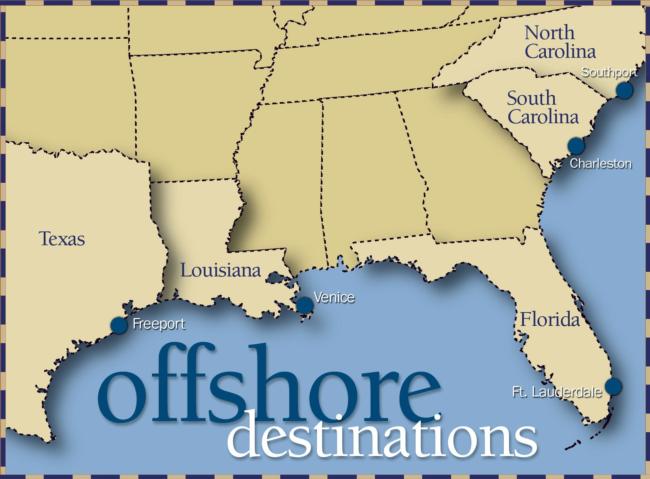10 great saltwater fishing spots for 2008
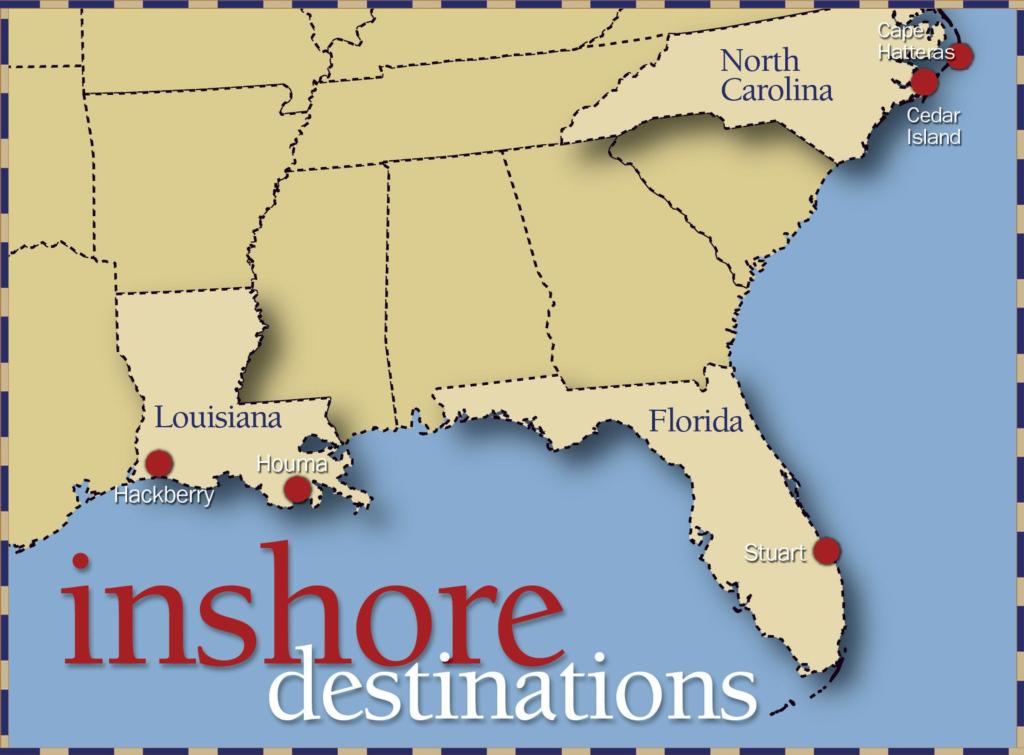
Inshore destinations
Hackberry, La.
Speckled trout (topwater fishing)
The best spotted seatrout fishing anywhere may be found at Lake Calcasieu in Louisiana. Anyone who has never seen speckled trout feeding on top like bluefish has to see it to believe it.
Vast Lake Calcasieu has two water depths – shallow and skeg-shatter. Calcasieu fishermen use trolling motors and poles to navigate channels between oyster beds. They anchor with grapnels or use sea anchors when they only want to slow their drifts.
Gulf winds can make the water rough, but nothing stops the specks from biting. Birds work baitfish and swarming shrimp, which the specks chase to the surface. Jigs with soft-plastic trailers and float rigs baited with shrimp are standard speck catchers. But when specks are in a surface-feeding frenzy, a topwater lure turns them on.
Bag limits are incredibly liberal, unless you are a native and accustomed to a full ice chest. Catching a speck topping 5 pounds each trip is usual, and the fishing is good most of the year.
Lodging and guides – Hackberry Rod and Gun Club: 888.762.3391; hackberryrodandgun.com
Houma, La.
Red drum (fly-fishing)
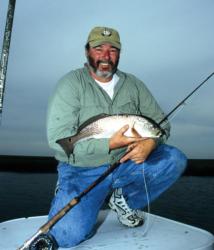 Red drum are caught in all Southern coastal waters. But no place can beat Louisiana for sheer numbers. Lots of other places teem with redfish. But near Houma, fly-fishermen find what they envision in their wildest dreams.
Red drum are caught in all Southern coastal waters. But no place can beat Louisiana for sheer numbers. Lots of other places teem with redfish. But near Houma, fly-fishermen find what they envision in their wildest dreams.
It’s nothing to see more than 200 red drum per day within fly-rod range. While that feat is possible in other places, so is seeing 200 other fishing boats.
The marshes of southwest Louisiana are so vast there is plenty of room. Once an angler launches his boat, he may never see another boat until he returns to the ramp.
Trolling motors and poling platforms are standard equipment. The fish bite best in spring and fall, but can be caught in winter as well. Summertime is downtime. An angler may see lots of fish, but winds off the Gulf cloud the water and heat it up, making the fish too lethargic to strike a fly. The best time to find active fish is dawn, since the wind generally increases by midmorning. It pays to carry along a heavier rod and/or fly line than standard 7- or 8-weight redfish fare for windy conditions, or switch to spinning rigs and toss topwater lures.
Lodging – Fairfield Inn Mariott: 985.580.1050;
marriott.com
Guide – Marty Authement, Marsh Madness: 985.688.4495; marshmadness.net
Cape Hatteras, N.C.
Red drum, bluefish, striped bass (surf fishing)
There’s nothing like feeling the surge of a big fish with the roll of the surf in his favor, eating line off a spinning reel while the angler is holding it and hoping the fish turns before the spool empties. The world-record red drum, or “channel bass” as adult reds are called in North Carolina, was caught from the Cape Hatteras surf and weighed 94 pounds. It’s unlikely the record will be beaten in the same location because fish that size can no longer be retained. But red drum topping 50 pounds are routinely caught and released at Cape Hatteras National Seashore.
Besides red drum, big bluefish weighing into the teens and striped bass weighing more than 30 pounds are routinely caught by surf fishermen. The sandy strand is the domain of beach buggies and four-wheel-drive pickups sprouting long, heavy surf rods and CB radio antennae. Anglers scan the surf for signs of baitfish and birds, or visible fish. They read the beach for sloughs and bars during low tides and return at higher tide stages to fish the bottom anomalies.
There is controversy about the closure of some popular beach driving-access locations in some of the especially good fishing locations. Before heading to Hatteras, anglers should visit the Web site for the status of access locations and beach driving information. The best fishing occurs in October through January. Visit nps.gov/caha for more information.
Lodging – Hatteras Marlin Motel: 866.868.2460; hatterasmarlin.com
Stuart, Fla.
Red drum, snook, permit (light tackle)
Pick your passion, whether it’s snook, tarpon, jack crevalle, speckled trout, bluefish, false albacore, ladyfish, flounder, red drum, pompano, permit, dolphin, king mackerel or sailfish, and it swims inside or just outside the Indian River Lagoon. The importance of all of these inshore and nearshore game-fish species is that they can be caught with light tackle or fly-fishing gear.
With Florida weather usually gorgeous, the Indian River Lagoon hosts a year-round fishery, and many guides make their living fishing the area, jumping from fish to fish with the subtle changes of the seasons. Most of the time, there are several species biting at the same time, so anglers who don’t have experience on these waters rely on professional guides who give them a smorgasbord of choices 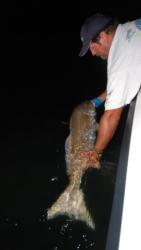 before heading out.
before heading out.
Sometimes, conditions can be too windy for fly-fishing. But it’s an easy switch from fly tackle to light tackle, whether casting soft plastics for specks, spoons for false albacore or live baits for snook.
Lodging – River Palm Cottages: 800.305.0511; riverpalmcottages.com
Guides – Greenwater Charters: Captain Duber Winters at 772.631.1023 or Captain Ray Winters at 772.631.1004; greenwatercharters.com
Cedar Island, N.C.
Giant red drum, tarpon (bait-fishing)
For the biggest double-whammy inshore game-fishing thrill of all, nowhere beats Pamlico Sound. Summer is the time to go, when tarpon are jumping during the day and red drum patrol the sandbars at night. The combination is enough to give inshore anglers insomnia.
In June, tarpon move into the sound. By July, the fishing is as hot as the water. Anglers catch them by spotting the flashy fish surfacing, then motoring stealthily ahead of them and dropping anchor. Cutting croaker or mullet into chunks, they bait as many as eight rods, setting them in a circle around the boat. Pamlico guides are experts at landing the fish, rather than “jumping” them, with success rates as high as 90 percent.
Red drum topping 50 pounds arrive in July, and both species stay until September.
Catches of more than a dozen giant reds in one night are common, and the technique is the same, fishing cut baits on the bottom.
Lodging – Driftwood Motel: 252.225.4861; clis.com/deg
Guides – Captain George Beckwith Jr., Down East Guide Service: 252.249.3101; pamlico-nc.com/guide. Captain Charles Brown, Old Core Sound Guide Service: 252.728.2422; oldcoresound.com
Venice, La.
Yellowfin tuna (kite fishing)
Some of the biggest yellowfin tuna anywhere swim in the Gulf. For a real thrill, Venice anglers go fly a kite.
Yellowfin tuna blow up on any bait or flying-fish lure skipping across the water, sometimes missing it several times before making a hookup. The advantage of kite fishing is that the normally leader-shy fish cannot detect the leader. Baits and lures also swim more naturally to incite the feeding instinct.
Gulf yellowfin average 40 to 80 pounds, but can weigh more than 200 pounds. Heavy tackle, including 50- and 80-pound-class rigs are used most often for yellowfin tuna. But 130-pound-class rigs are needed for the more serious fishing for the bigger “pigs.”
Hooking a super tuna on stand-up tackle begins a contest to see who will give up first, the tuna or the fisherman. It’s a game of strong backs and knees – and lots of them. A cockpit of hefty bodies needs to be in place before setting the spread because multiple hookups are the rule. Several reels scream out at the same time, so there must be enough anglers onboard to handle the action.
Lodging – Cypress Cove Marina and Lodge: 888.534.8777; rodnreel.com/cypresscove
Guide – Captain Kerry Milano of Outer Limit Fishing Charters: 504.915.9991; outerlimitcharters.com
Southport, N.C.
King mackerel, African pompano (live bait)
Live-bait techniques for catching king mackerel were born in southeastern North Carolina. These techniques started the king mackerel tournament-fishing craze. But the art of slow-trolling live baits is not only tops for whopping king mackerel that can weigh more than 50 pounds – many other game fish strike them in these waters, including cobia, barracuda, amberjack, sailfish, dolphin, sharks and super-sized Spanish mackerel.
The African pompano is a unique species that should be on every angler’s lifetime catch list. These “swimming mirrors” look like gigantic renditions of aquarium fish called lookdowns. Powerful, fast, with incredible endurance, African pompano are routinely caught in July and August at Frying Pan Shoals, offshore of Southport. The other species lurk there as well, with many of them swimming right along the beaches and artificial reefs just off the coast.
The best fishing occurs between April and November for most species, but there’s only a narrow 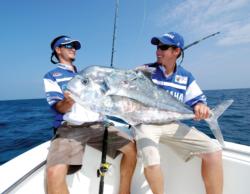 window for African pompano. The broken structure and live-bottom areas, and the vast mixing zone created by the Cape Fear River, combine to form one of the richest game fisheries anywhere.
window for African pompano. The broken structure and live-bottom areas, and the vast mixing zone created by the Cape Fear River, combine to form one of the richest game fisheries anywhere.
Lodging – Fat Flounder Lodge: 866.395.3474; fishsouthport.com/Lodging.html
Guides – Captain Butch Foster, Yeah Right Charters: 910.845.2004; yeahrightcharters.com. Captain Brant McMullan, Ocean Isle Fishing Center: 910.575.3474; oifishingcenter.com
Charleston, S.C.
Dolphin, billfish (trolling)
Charleston’s harbor, with its large-rock breakwaters, hosts an outstanding sport-fishing fleet. Billfish and meat fish abound, including yellowfin and blackfin tuna, white and blue marlin, sailfish, wahoo, sharks and king mackerel.
The bite warms up in late March or early April and stays on all summer, shutting down in November. Offshore-trolling techniques include fast trolling with lures rigged with ballyhoo or strip baits and kite fishing. Charleston skippers are masters of innovation, pulling dredges and teasers, as well as secret techniques they will not mention because the competition is keen.
The fish are found along the continental break, although the dolphin bite can move well inshore of the break. Every trip will result in dolphin catches, and many will top 30 pounds – with some going more than double that weight. If you are going to pick a top fish for the Charleston area, go for dolphin.
Lodging and guides – Charleston Harbor Resort and Marina: 888.856.0028; charlestonharborresort.com. Charters may be booked through the marina
Freeport, Texas
Snapper, grouper, ling (bottom fishing)
Small-boat fishing for bottom fish is popular on the structure offshore of the Freeport/Galveston area. Big red snapper are the draw, but grouper and ling are also caught, along with other pelagic species such as king mackerel, dolphin, tuna, shark and amberjack. Center-console boats are the norm for bottom fishing and economical to run. It’s some of the best fishing for big red snapper anywhere.
Lodging – Holiday Inn Express: 979.265.5252; holidayinn.com
Guide – Captain Leaf Potter, Texas Saltwater Fishing Guide: 832.428.3340; texassaltwaterfishingguide.com
Fort Lauderdale, Fla.
Swordfish (night-fishing)
For anglers looking for the nighttime experience of a lifetime, South Florida is the destination. Hooking up a swordfish is something few anglers ever experience because they would rather be home in bed. Thanks to better management, swordfish populations are growing healthier, and anglers are catching them routinely. Many big-game anglers have caught the other billfish available and need to add swordfish to their lists.
Swordfish are caught with lighted baits from deep-water areas. The advantage of fishing out of Fort Lauderdale is the ride is much shorter to the deep-water areas than other places on the Atlantic coastline.
Lodging – Amerisuites Fort Lauderdale: 954.763.7670; amerisuitesftlauderdale.com
Guides – Goodfellas Charters: 954.254.7700; goodfellascharters.com
